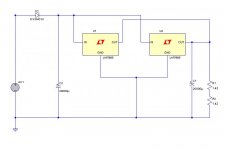Quick question,
I am building a 27 preamp with 6BX7 followers. I am on a budget and a 5V CT transformer for the 27 filaments is not in the cards right now.
I do however have a few LM7805's salvaged from old gear.
Is it safe to rectify a 6.3V winding with a diode and then run the 27 filaments in series with paralleled 7805s?
I tried a sim in LTSpice and and it appears to work fine. A quick test with 2 used 27's produced decent results. Except the two filaments are not exactly matched one is dropping about 2.7V the other 2.3V.
Is this "OK"? or should I look to "balance" the two filaments better somehow.
I am building a 27 preamp with 6BX7 followers. I am on a budget and a 5V CT transformer for the 27 filaments is not in the cards right now.
I do however have a few LM7805's salvaged from old gear.
Is it safe to rectify a 6.3V winding with a diode and then run the 27 filaments in series with paralleled 7805s?
I tried a sim in LTSpice and and it appears to work fine. A quick test with 2 used 27's produced decent results. Except the two filaments are not exactly matched one is dropping about 2.7V the other 2.3V.
Is this "OK"? or should I look to "balance" the two filaments better somehow.
Attachments
Use a full-wave bridge. Half-wave puts DC through the transformer and has a higher RMS value for the same DC output current. Parallel regulators won't work well unless you add a small resistor in series with each output (0.1 Ohm will do)to balance currents. Otherwise one will loaf while the other runs at its current limit. 27s are not intended for series operation, so you may have to try a few to find ones that match (try for 5%).
Use a full-wave bridge. Half-wave puts DC through the transformer and has a higher RMS value for the same DC output current. Parallel regulators won't work well unless you add a small resistor in series with each output (0.1 Ohm will do)to balance currents. Otherwise one will loaf while the other runs at its current limit. 27s are not intended for series operation, so you may have to try a few to find ones that match (try for 5%).
Thanks Tom!,
I was thinking along those same lines originally.
I have (2) NOS 27's one is RCA one is Cunningham (probably both just prior to the "merge" of the two company's production. I tried them and found them to be off about 10%, is there any other suggested way of "matching" them"?
I don't recommend running the 27 in series if you can avoid it, and if you do you will have to find ones that match well. (Best done in circuit) Even constant current operation will not assure that the voltage divides properly across the filaments of these tubes as their heated resistances are not very consistent. (A ccs should prevent a tube from self destructing.) Remember these are the first North American tubes to use indirect heating and the filament/cathode design and process requirements weren't completely understood at the time. (Types developed just a few years later are much more robust.)
Last edited:
I don't recommend running the 27 in series if you can avoid it, and if you do you will have to find ones that match well. (Best done in circuit) Even constant current operation will not assure that the voltage divides properly across the filaments of these tubes as their heated resistances are not very consistent. (A ccs should prevent a tube from self destructing.) Remember these are the first North American tubes to use indirect heating and the filament/cathode design and process requirements weren't completely understood at the time. (Types developed just a few years later are much more robust.)
Thanks also to Kevin,
Since these tubes are old NOS Mesh Plates and I do not have a lot of funds to be replacing "burned out" tubes, I think I will find another way to power the filaments.
My 6.3V winding is Center Tapped, maybe small bridges and resistors can provide 2.5V.
I have a small supply of used tubes to "play" with as far as testing the circuits.
Another option is to go with 37's? I will "model" them in the place of the 27's.
Maybe I will "prototype" it with the 37's and then later on go with 27 or 26's, when my "budget" allows for better quality components.
- Status
- Not open for further replies.
